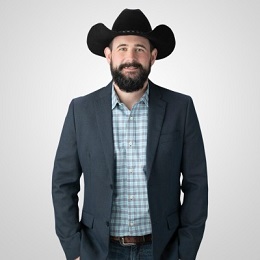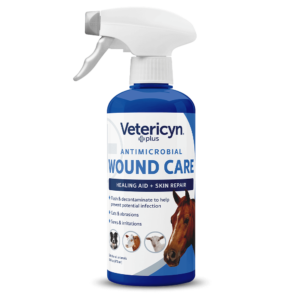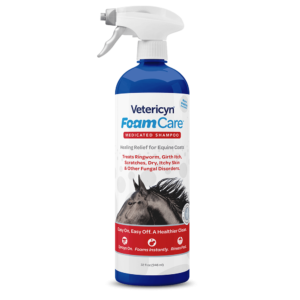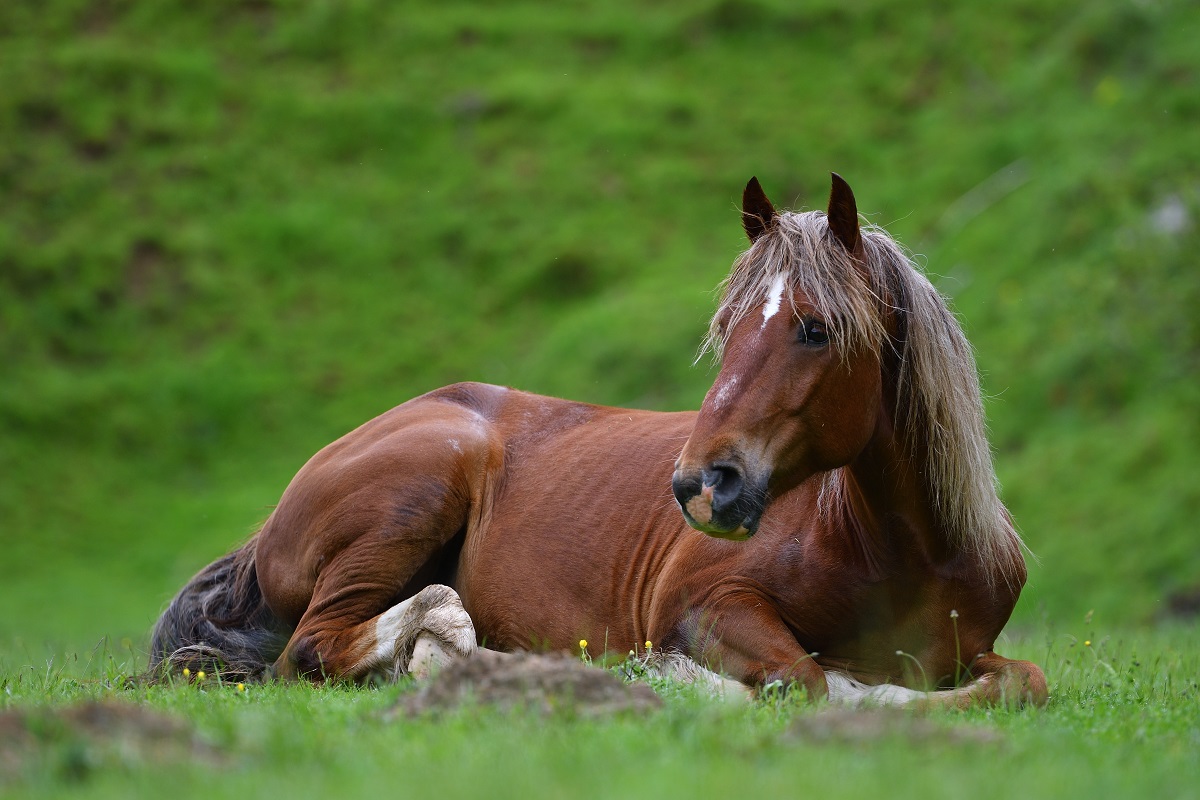As a horse owner, you know horses possess an uncanny ability to injure themselves. Whether you discover a mystery gash during morning feed or witness a scrap unfold during your ride, every wound sends a spike of worry through your heart. Fortunately, most wounds heal without drama—but one complication can turn a simple cut into an endless ordeal called proud flesh.
What is proud flesh in horses?
When normal wound healing spirals out of control, proud flesh emerges as your horse’s body produces excessive tissue. This creates a raised, puffy mass that blocks the wound closure entirely. Without proper treatment, proud flesh can leave your horse with chronic pain and recurring injuries, including a wound that just won’t heal. But with prevention and proactive equine care, you can get your horse’s healing back on track (and possibly prevent proud flesh in the first place).
This article explores the causes, treatments, and prevention strategies for proud flesh in horses. Learn how to help your horse heal comfortably so you can confidently hop back in the saddle.
What is Proud Flesh?
When your horse’s natural healing process shifts into overdrive, the natural balance of tissue repair is disrupted. The result? Proud flesh.
To better understand proud flesh, it helps to understand wound healing in general. Importantly, wound healing occurs in four stages:1
- Hemostasis – Stops the bleeding
- Inflammatory – Eliminates debris
- Proliferation – Builds new tissue
- Maturation – Strengthens the repair
In healthy healing, each stage transitions smoothly into the next. However, irritation or disruption can stall the process, potentially leading to chronic wounds.
Specifically, during the proliferation phase, the body creates granulation tissue to fill the wound gap. This tissue builds a bridge for new skin cells to grow across. Typically, the granulation tissue fills the wound to skin level, then stops growing while skin cells migrate across the surface to seal the wound.
Proud flesh occurs when the proliferation phase continues unchecked. The granulation tissue keeps growing and growing, eventually rising above the skin surface.
The excess tissue creates a physical barrier that prevents skin cells from covering the wound. Since the cells need a flat surface to move across, the wound remains open and vulnerable until the proud flesh is addressed. 2
This is one of several horse skin conditions that require close monitoring and proactive care.
Symptoms of Proud Flesh in Horses
Early detection can simplify how to treat proud flesh in horses. If your horse has suffered a recent injury, monitor the wound for these signs of proud flesh formation: 3
- Mushroom-shaped flesh rising above the wound surface
- Bright pink or red appearance with a rough, bumpy texture
- Heat radiating from the wound
- Swelling around the edges
- Pain when touching near the tissue
- Excess discharge
- Wounds that refuse to shrink
- Tissue that easily reopens
Note that proud flesh almost exclusively appears on horse legs, particularly below the knee and hock. If you see excess tissue growth elsewhere, consider other possibilities like a tumor or fungal infection, or even less common diagnoses such as equine sarcoidosis.
Unlike minor scrapes that improve daily, proud flesh is not likely to heal independently. If you notice any raised tissue developing in a wound, contact your veterinarian right away.
Trust your instincts when evaluating wounds. These subtle early warning signs, combined with your knowledge of your horse’s normal healing patterns, can be invaluable in catching proud flesh before it becomes a major problem.
Causes of Proud Flesh in Horses
Current research points to a prolonged inflammatory response as the culprit behind excessive tissue growth. Several factors can extend inflammation and increase proud flesh risk:4
- Infection – Bacteria irritate the wound and keep inflammation active, creating a cycle where the body continuously tries to fight off invaders by producing more tissue. Since proud flesh wounds are closer to the ground, they are often easily contaminated with bedding and manure.
- Movement – Wounds in areas of high motion are constantly stretched and irritated. Every step your horse takes could disrupt healing tissues. This triggered inflammation may result in excess granulation tissue production.
- Missing skin – Without enough surrounding skin to close the wound, the granulation may overfill the gap and continue building on top of itself.
- Poor bandaging – Improper bandaging technique can inadvertently encourage overgrowth. Poor wrapping may trap moisture, increase contamination risk, or create pressure points that can interfere with your horse’s normal healing process.
Horses also face some anatomical disadvantages that promote proud flesh growth. In particular, the lower legs lack a muscle layer (called the panniculus carnosus) that helps wounds contract in other body parts. Plus, the skin around the legs is already stretched taut, so there isn’t as much room for the skin to cover a newly opened wound.5
How is Proud Flesh Treated?
Professional veterinary care is crucial for managing proud flesh effectively. Your veterinarian will assess the wound and, based on its severity and location, determine the most appropriate treatment strategy.
For minor proud flesh, veterinarians may prescribe topical steroid ointments combined with bandaging to halt tissue overgrowth. The steroids reduce inflammation, while pressure bandaging helps flatten the tissue. Some veterinarians also use laser therapy to remove proud flesh and promote healing on areas of smaller overgrowth.6
More extensive proud flesh growth may require surgical debridement. In this case, your vet will trim the excess tissue to or slightly below skin level. Your horse will likely need sedation to stand still during the procedure, but it’s mostly pain-free, and local anesthesia is rarely necessary.7 After debridement, your horse will receive a “bandaid” or short-term wrap that requires removal after the bleeding stops.
For wounds that won’t close completely due to extensive skin loss, skin grafting may be necessary. Common grafting techniques include taking skin from a looser area like the chest. This meticulous procedure requires strict stall rest and specialized aftercare.8
Recovery During Proud Flesh Treatment
Recovery time for proud flesh treatment varies depending on the wound size and location. Small areas might heal within weeks, but extensive proud flesh could require months of careful treatment with regular vet checkups.9
Following surgery, your veterinarian might prescribe antibiotics, anti-inflammatory medications, and specific wound dressings to prevent regrowth.
Proud Flesh Prevention Tips
Prevention is your most powerful tool against proud flesh development. Mastering proper wound care techniques can help you avoid this complication altogether.
#1: Proper Wound Cleaning
If your horse gets injured, gently clean the wound to remove debris and bacteria without damaging healthy tissue.
Flush the wound with a specialized animal wound care solution to remove contaminants and reduce inflammation. Gentle, consistent cleaning will create an optimal environment for healthy tissue to grow.
#2: Proper Bandaging
Contact a vet as soon as possible when you notice a large wound. Your vet can suture the skin edges, creating an ideal environment for uncomplicated healing.
For wounds that can’t be sutured, proper bandaging techniques will reduce the chances of excess granulation and help prevent infection. Change bandages daily at first to monitor your horse’s healing progress. If you’re not sure how, request a hands-on demonstration from your vet.
Once the granulation tissue completely covers the wound bed, discontinue bandaging. While it may be tempting to keep the wound covered, continued bandaging after this point can cause inflammation and lead to more granulation tissue growth.
#3: Infection Fighting Treatments
Bacteria thrive in warm, moist environments. While you can’t wrap your horse in bubble wrap (tempting as that might sound), you can reduce their risk of infection through prevention.
Apply an antimicrobial gel to new wounds to fight microbial growth. The gel will moisturize, protect, and soothe your horse’s wound to reduce the risk of inflammation and promote healthy healing.10
#4: Rest
Your horse doesn’t understand the connection between galloping around and delayed wound healing. They only know that they want to run. This is where your judgment becomes crucial.
The moment a wound occurs in a high-motion area, put your horse on stall rest. Maybe they’ll give you the stink-eye for a few days, but this rest will help prevent the wound from turning into a red, puffy cloud.
Bored horses can develop destructive habits that can also irritate their wounds. For the sake of your horse’s health and sanity, entertain them during stall rest with toys, hidden treats, or puzzle feeders.
If the wound is in an area with lower movement, you can restrict your horse to short walks instead of strict stall rest. Use your best judgment to determine whether a wound needs strict stall rest or controlled turnouts.
Promote Fast and Complete Wound Healing with Vetericyn
Every horse owner faces challenges when healing their horse’s wounds, and proud flesh can be one of the trickiest and most frustrating challenges of them all.
Luckily, you can tackle this common complication head-on with the knowledge you’ve gained about early recognition, proper treatment, and prevention strategies. By staying vigilant and maintaining proper wound hygiene, you’ll give your horse the best chance at a smooth, uncomplicated recovery.
If you’re ready to stock up on horse health essentials, explore our complete selection of equine care products to keep your horse healthy, comfortable, and ready for your next ride.
 Reviewed by C. Scott Van Winkle
Reviewed by C. Scott Van Winkle
Scott has been with Innovacyn for the past 11 years and has been working within the Burlingame portfolio of companies for the past 23 years. Scott brings a diverse background to Innovacyn. With an upbringing as the 5th generation on his families cattle ranch, Scott has a passion for animal health and the continuous improvement surrounding agricultural practices. Scott earned marketing and business management degrees from the University of Idaho and holds an Executive MBA from Pepperdine University.
Sources:
- The Horse. Understanding Proud Flesh. https://thehorse.com/1100306/understanding-proud-flesh/
- University of Minnesota Libraries. Large Animal Surgeries — Supplemental Notes. https://open.lib.umn.edu/largeanimalsurgery/chapter/skin-loss/
- Horse Life. Understanding Proud Flesh in Horses. https://horselife.org/understanding-proud-flesh-in-horses/
- New England Equine and Medical Surgical Center. Equine Proud Flesh. https://www.newenglandequine.com/Articles/EquineProudFlesh.pdf
- Practical Horseman. Equine Proud Flesh Problems. https://practicalhorsemanmag.com/health/equine-proud-flesh-problems/
- Del Oeste Equine Hospital. Skin Grafts — A Faster Way to Heal Large Wounds. https://deloeste.vet/skin-grafts-a-faster-way-to-heal-large-wounds/
- Horse and Rider. How to Treat and Prevent Proud Flesh. https://horseandrider.com/horse-health-care/prevent-proud-flesh/


